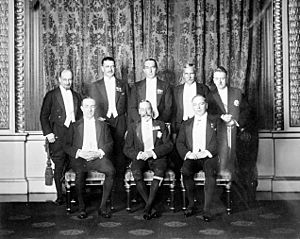1926 Imperial Conference facts for kids
Quick facts for kids 1926 Imperial Conference |
|
|---|---|

The King (front, centre) with his prime ministers. Standing (left to right): W.S. Monroe (Newfoundland), Gordon Coates (New Zealand), Stanley Bruce (Australia), J. B. M. Hertzog (Union of South Africa), W. T. Cosgrave (Irish Free State). Seated: Stanley Baldwin (United Kingdom), King George V, William Mackenzie King (Canada).
|
|
| Host country | |
| Date | 19 October 1926– 23 November 1926 |
| Cities | London |
| Heads of State or Government | 8 |
| Chair | Stanley Baldwin (Prime Minister) |
| Follows | 1923 |
| Precedes | 1930 |
| Key points | |
|
Balfour Declaration, constitutional arrangements
|
|
The 1926 Imperial Conference was an important meeting held in London from October 19 to November 23, 1926. It brought together the prime ministers from different parts of the British Empire, known as Dominions. This conference is famous for creating the Balfour Declaration. This declaration stated that all the Dominions were equal to the United Kingdom. They were "autonomous communities," meaning they could govern themselves and were not controlled by the UK. During this meeting, the term "Commonwealth" was officially chosen to describe this group of nations.
This conference was planned to happen right after a meeting of the League of Nations in Geneva, Switzerland. This was done to make it easier for the leaders from the Dominions to attend, as they wouldn't have to travel as much.
Contents
What Was Discussed?
The main goal of the 1926 Imperial Conference was to figure out how the different parts of the British Empire would work together in the future. They wanted to create a clearer understanding of their relationships.
The Balfour Declaration: A Big Change
One of the most important outcomes was the Balfour Declaration. This declaration officially recognized that the Dominions, like Canada, Australia, and South Africa, were equal in status to the United Kingdom. It meant they were independent nations within the British Empire, not under the UK's rule. This was a huge step towards these countries having more control over their own affairs.
The declaration also officially adopted the name "Commonwealth" for this group of nations. This new name showed that they were a community of equal partners.
Future Plans for the Commonwealth
The conference set up a special group called the Inter-Imperial Relations Committee. This committee was led by Arthur Balfour. Their job was to think about how the Commonwealth should be organized in the future.
They decided against having a strict, written constitution, which some leaders had suggested. However, they also didn't fully agree with the idea of completely ending the empire. The committee's ideas were accepted by everyone at the conference on November 15. Newspapers also reacted positively to these new plans.
Who Attended the Conference?
The conference was hosted by King-Emperor George V. The main attendees were the prime ministers and other important government officials from the United Kingdom and the Dominions. These leaders came together to discuss the future of the British Empire and the relationships between its member nations.
The countries that sent representatives included:
These meetings were crucial for shaping the modern Commonwealth of Nations.

